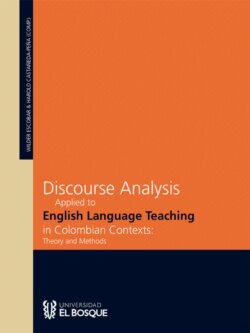Discourse analysis applied to english language teaching in colombian contexts: theory and methods

Реклама. ООО «ЛитРес», ИНН: 7719571260.
Оглавление
Wilder Yesid Escobar Alméciga. Discourse analysis applied to english language teaching in colombian contexts: theory and methods
Content
About the Author
Introduction
Classroom language viewed as discourse
Discourse analysis in general educational settings
Discourse analysis in foreign and second language educational settings
Summary and discussion
About the Author
Introduction1
Theoretical Framework
Research Design
Data Analysis
Do in Speech Markers and Conversation Fillers
Common Socio-cultural Conventions within an Interpretive Community
Forms and Functions of Agreement and Disagreement
Word Associations
Conclusions
About the Author
Introduction
Language Classroom Interaction
Research on Language Classroom Interaction
Three Research Works in Language Classroom Interaction
Conversation analysis in language classroom interaction
First research work: the influence of students’ Spanish lexicon in English language classes
Second research work: asking about content and adding content
Third research work: code switching to learn the L2 equivalent of an L1 word: the RPA sequence
Implications of the Three Research Works
Why Doing Research on Language Classroom Interaction?
Further Research
About the Author
Introduction
Main question:
Sub question:
Theoretical framework
The Concept of Identity
Construction of Identity
Language and identity
Identity as language learners
Classroom interaction
Research Methodology
Instruments for data collection
Research approach
Methodology for data analysis
Results of the research experience
Students and their passive resistance
L1 vs. L2 strategies for understanding
Circulating power: struggles for knowledge
Students as “answerers.”
Alternative interactions: fighting against required answers
Identity shapers
The teacher as an identity shaper
Identity construction through power relations
Conclusions
About the Author
Introduction
Language, Identity and Discourse: Theoretical Concepts
Method
Instructional design
Findings
Conclusions
Further Research
Conclusions
The progressive evolution of discourse analysis and what it could represent for language education today at local and global levels
The understanding of language makeup and behavior and how discourse analysis could promote advantageous findings about linguistic structures and language use
Establishing connections between language and society to describe how language structures social life and, reciprocally, how social life structures language
Exploring the intricate relation between language and the self to depict identity-forming processes in foreign language interaction
Individual and collective dynamics of social positioning which strive for distinctiveness as well as membership
References. Introduction
Chapter One
Chapter Two
Chapter Three
Chapter Four
Chapter Five
NOTES
Exploring Pragma-grammatical Roles of “Do” in EFL Students’ Spoken Production
From Underdogs to Important Speakers: Unveiling Language Learners’ Identities through Peer-approval Discourses
Отрывок из книги
INTRODUCTION
CHAPTER ONE CLASSROOM DISCOURSE ANALYSIS: OUTLINING THE FIELD
.....
Why Doing Research on Language Classroom Interaction?
Further Research
.....